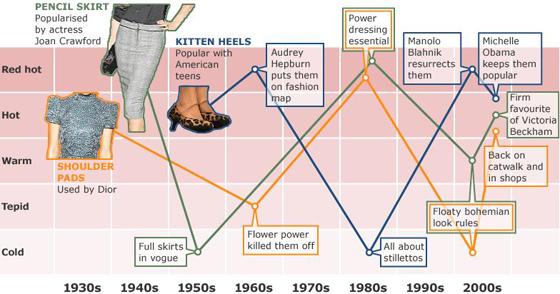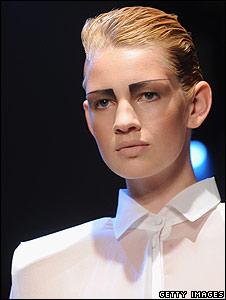
For years shoulder pads were fashion suicide. But they are back on the catwalks of London Fashion Week, back in the shops and back in our wardrobes. How did this happen?
They may have defined fashion in the 1980s, but most of the 90s and noughties have been spent sniggering at pictures of yourself, your mother or Alexis Carrington wearing them.
But what was unimaginable just a few years ago has now happened - shoulder pads are back in the shops and back in our wardrobes, for the first or second time round.
 Back at London Fashion Week
Back at London Fashion Week
So how did we find ourselves handing over our hard-earned money for what was considered a fashion faux pas for so long?
Be it music, food or cars, all trends have a life cycle and none more so than fashion trends. One of the first people to try and pin down our adjustable attitude to what's hot and what's not was the highly-respected fashion historian James Laver. In 1937 he drew up a timeline of how a style is viewed over the years, which became known as Laver's Law.
This states that a trend does not start to look appealing until 50 years after its time. If you wear something 10 years after it was in fashion, you look "hideous", 20 years after you look "ridiculous" and so on. Only when you hit 50 years do things start tipping towards the positive and you look "quaint".
According to Laver's Law, shoulder pads should still look ridiculous. But the fashion industry has changed considerably in the last 72 years, and clothes are designed, produced and consumed in an entirely different way. But trends still have a life cycle - it's just more condensed.
Ironic choice
"The recycling of fashion trends has been speeded up," says Andrew Groves, course director for fashion at the University of Westminster.
"We now live in a fast-paced consumer society. Pictures of what's on the catwalks of London Fashion Week today will be on the internet today. Everything is absorbed quicker and we want it quicker. Looks hit the High Street much faster."
But some things remain the same, including the reason a trend goes from hot to not. What kills it off is boredom, say those in the industry. A trend starts off on a few and eventually goes mainstream, by which time the leaders - be they designers, models or trendsetters - have moved on. Eventually everyone else does too.
Then it goes through stages of being ridiculed and worn ironically - as Laver's Law charts - until it is largely forgotten. Only when it drops off the fashion radar - for both good and bad reasons - can it be rediscovered, says Mr Groves.
"It's the point when something that was viewed as old and outdated for so long starts looking refreshing," he says.
Dress like mum
And being refreshed is an essential part of the cycle. No one wants a carbon copy. The trend can't be exactly the same second or third time around, and usually isn't because a new generation of designers will have looked at it with fresh eyes.
"They don't necessarily see shoulder-pads, for instance, the way previous generations did, as part of a 'power' suit," says Times fashion editor, Lisa Armstrong. "For them it's just a really fun fashion statement that takes us away from all the soft, fragile looks of the past decade."
Welsh designer Emma Griffiths, 30, is just old enough to remember shoulder pads in the 80s, but on her mother. They've featured heavily in her last two collections for her label e.g... Her designs include skinny sleeves and fine tailoring, making a sharper silhouette than the quarter-back look sported by the likes of Sheena Easton and Joan Collins.
"I personally think you have to look back to see forward," she says. "My collections were inspired by my early, most powerful memories. I remember the way my mum dressed and how back then young girls dressed liked their mums.
"I've taken shoulder pads and reinterpreted them, rejuvenated them. First of all a few people were a bit shocked to see them again but could see I'd updated them and they worked in my designs. Women aren't stupid, they won't wear something if it doesn't look good."
 ... and now on early adopters Agyness Deyn and Kate Moss
... and now on early adopters Agyness Deyn and Kate Moss
What remains the same, however much a look has been rejigged, is the need to get the public thinking about it - and thinking about it in a new way if they've worn the style in the past.
The best way of doing this is getting the right people to wear it. Actresses Joan Crawford and Audrey Hepburn did back in the day, and the likes of models Kate Moss and Agyness Deyn do it today.
"Someone like Katie Price could kill a look but Kate Moss creates a stampede for it," says Mr Groves.
That stampede leads to mainstream acceptance and then we are back at the start. Boredom will follow... and so on.
Of course not everything comes back. The cycle ends for trends when they have outgrown any useful purpose.
"Take a bustle or the crinoline, they wouldn't work on the bus or in a tiny electric car," says Ms Armstrong.
"It's a serious point made frivolously, but fashion has to be relevant on some level otherwise it won't get worn. Then it's not fashion, it's just costume."
The rigidity of style rules has also changed in recent years. They're not so hard and fast anymore. Shoulder pads are just one detail in an outfit now, rather than its single defining feature.
"The rules don't exist like they did in the 1980s," says Mr Groves. "People pick and chose details to build their own style. Take skirt lengths, who can say what the 'fashionable' length is this season. They're all different, you just chose what length works for you."
But the public simply has to feel ready for a trend, even if they don't always quite realise they're ready, says Ms Armstrong. If they're not, it's over before it even really started.
"Not even Kate Moss could bring back the high-waisted jeans," she says.





